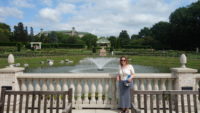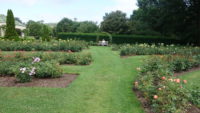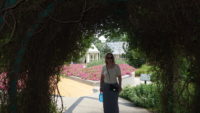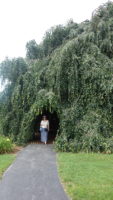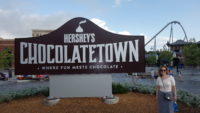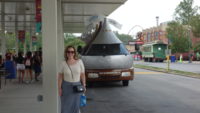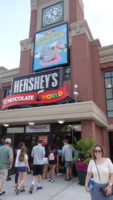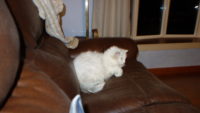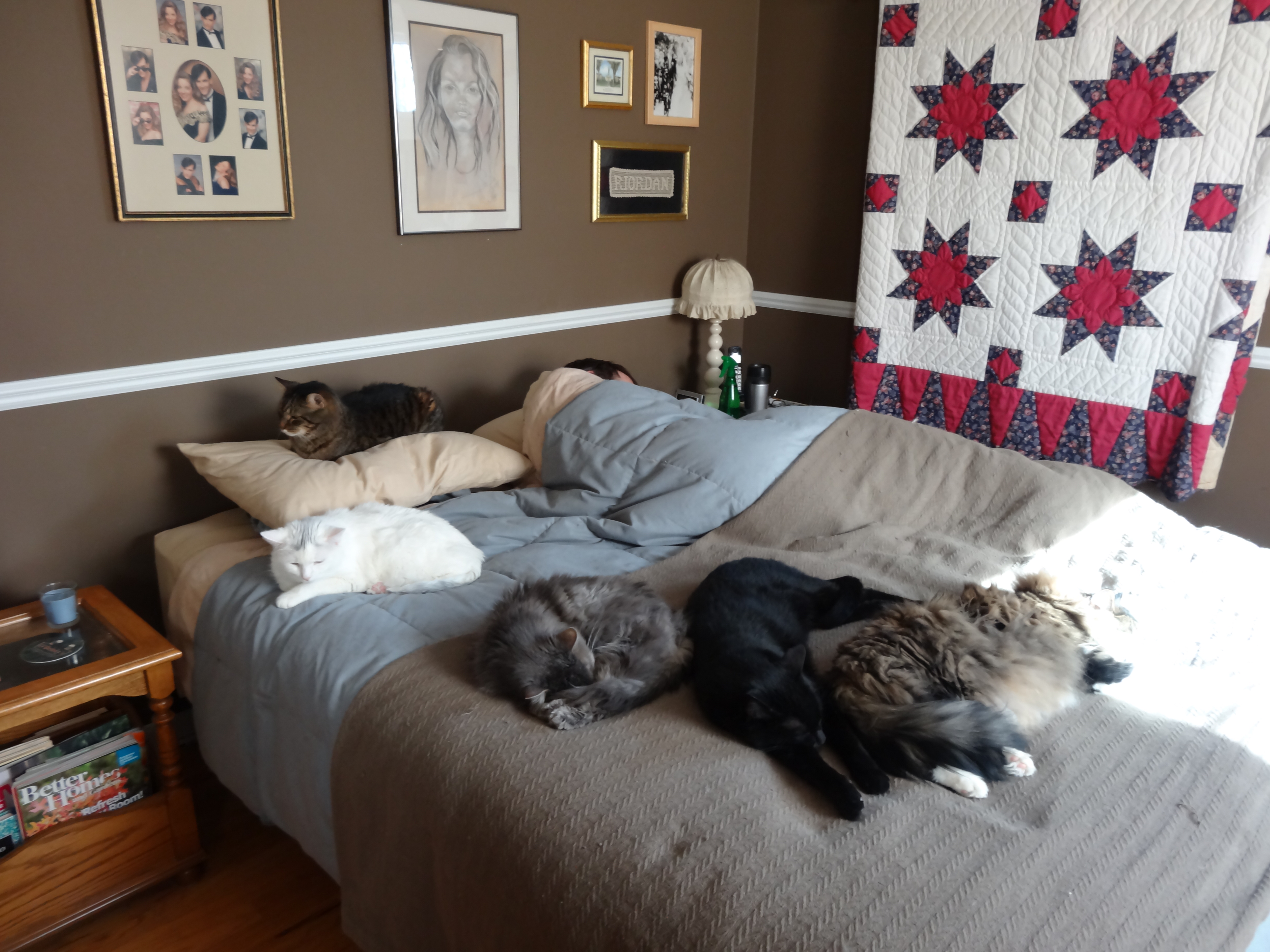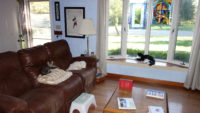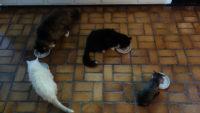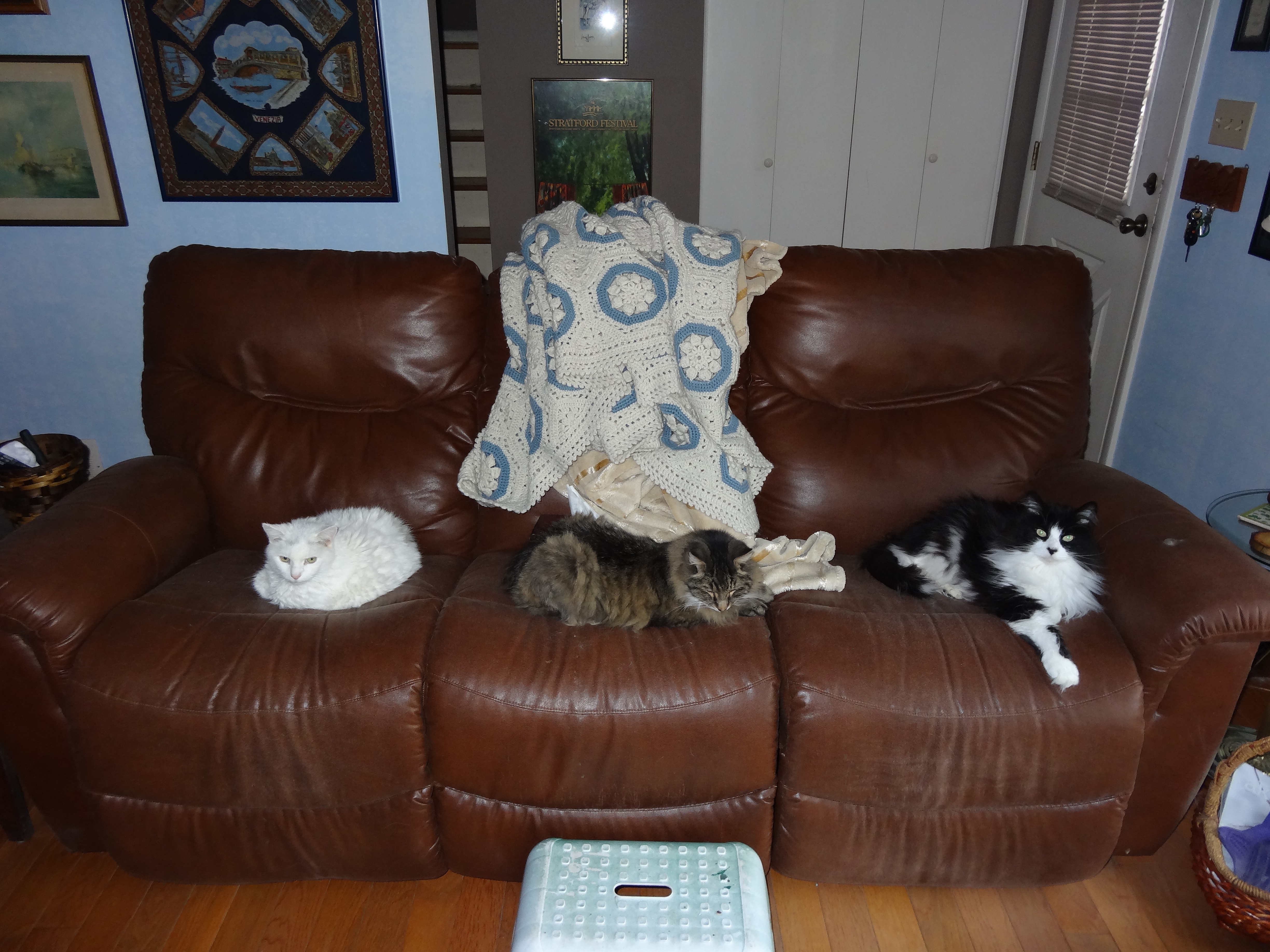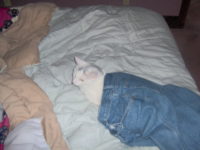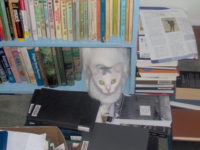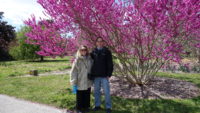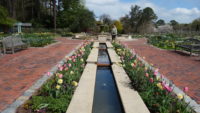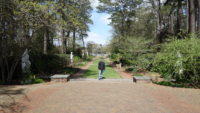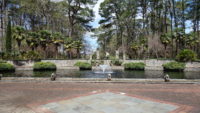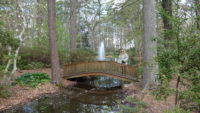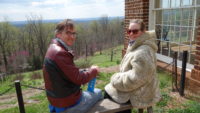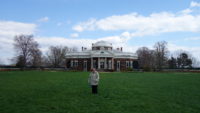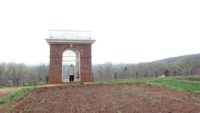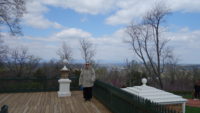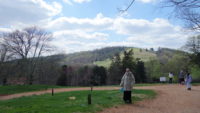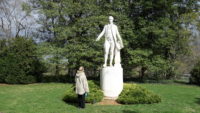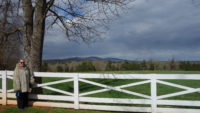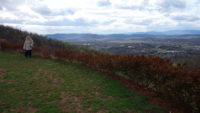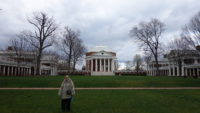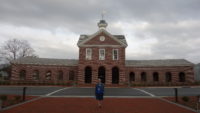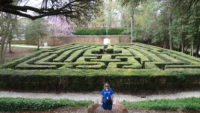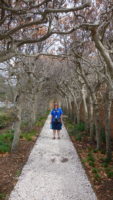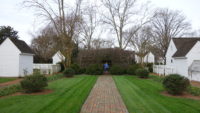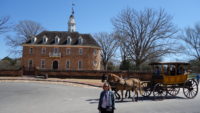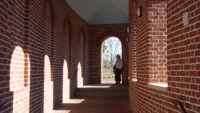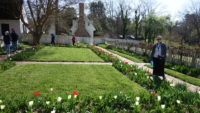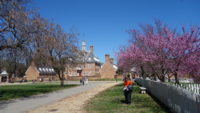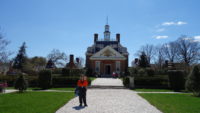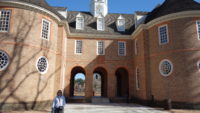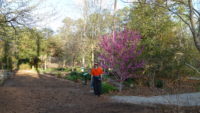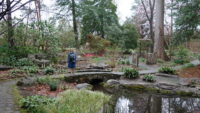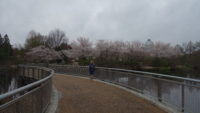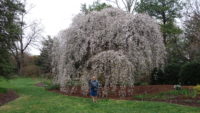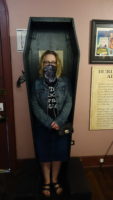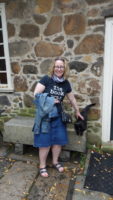 In a small, friendly community like New Baltimore, unexpected visitors drop by one’s house from time to time … but I was still surprised that someone was at the door at nine o’clock. Matthew had just gone upstairs to bed, so I was the one who answered the door and found Jennifer, a grade-school neighbor girl, holding a tiny ball of white fur in her cupped hands. She explained, “I found this kitten in the woods, and I didn’t see any mama cat or any other kittens, so I brought it home, but my mom said we can’t keep it, because of our dogs — it might not be safe.” I called for Matthew to come back downstairs. Taking the kitten from Jennifer, he said we’d keep it for a day or two, until we had a chance to get it to a shelter. Somehow, though, I had a suspicion that the proposed shelter trip would never come to fruition.
In a small, friendly community like New Baltimore, unexpected visitors drop by one’s house from time to time … but I was still surprised that someone was at the door at nine o’clock. Matthew had just gone upstairs to bed, so I was the one who answered the door and found Jennifer, a grade-school neighbor girl, holding a tiny ball of white fur in her cupped hands. She explained, “I found this kitten in the woods, and I didn’t see any mama cat or any other kittens, so I brought it home, but my mom said we can’t keep it, because of our dogs — it might not be safe.” I called for Matthew to come back downstairs. Taking the kitten from Jennifer, he said we’d keep it for a day or two, until we had a chance to get it to a shelter. Somehow, though, I had a suspicion that the proposed shelter trip would never come to fruition.
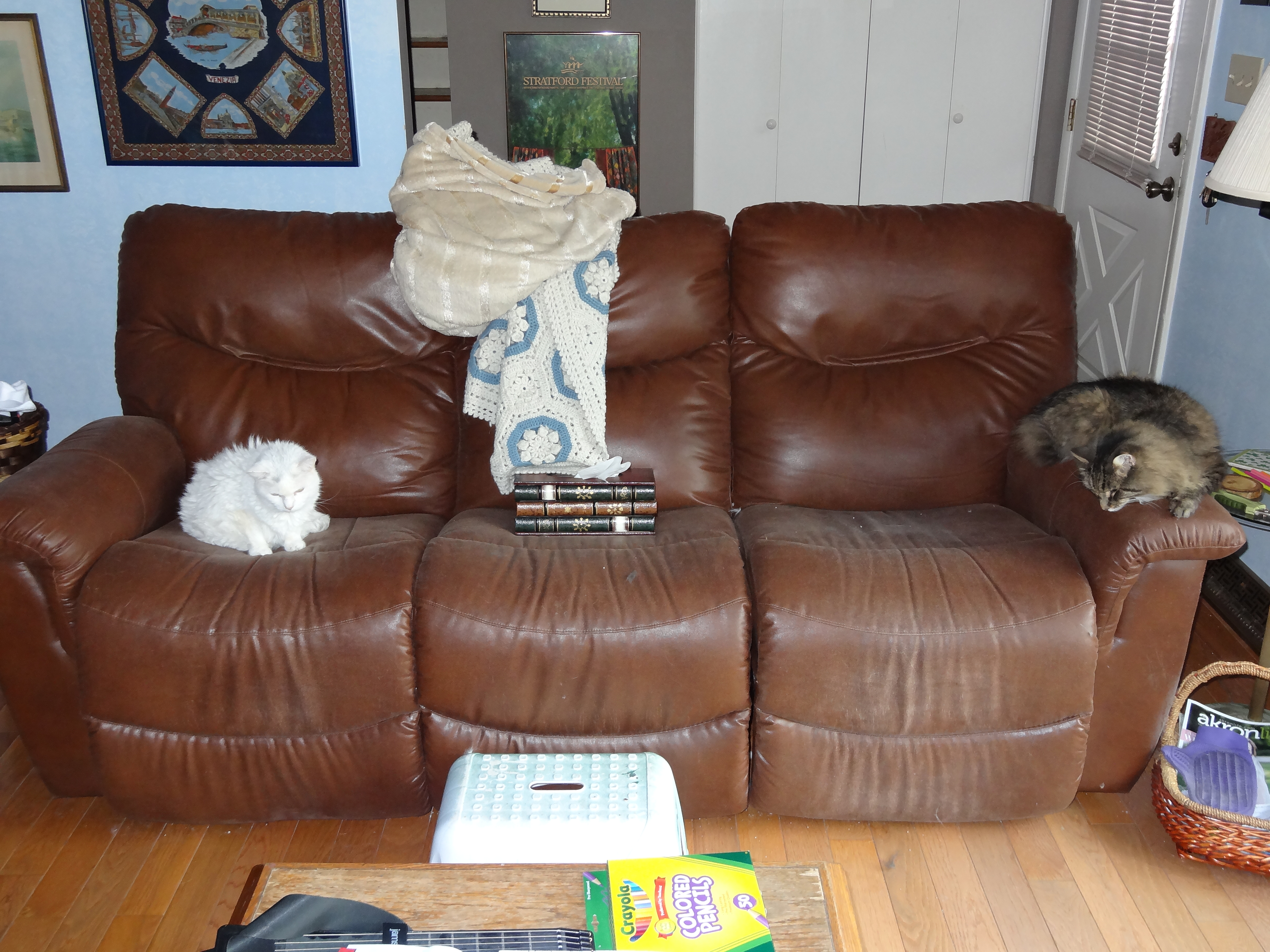 The kitten’s eyes were open, but they couldn’t have been for long. It was a tiny thing that couldn’t yet feed itself or even go to the bathroom without assistance. During those first few days, Matthew became the “mama-daddy,” feeding it formula with an eye dropper and “expressing” its bladder, a term and technique we learned from Matthew’s brother. Apparently, mama cats lick their kittens’ lower abdomens to encourage them to urinate, so dampening a washcloth with warm water and rubbing a kitten’s belly with it effects a similar sensation.
The kitten’s eyes were open, but they couldn’t have been for long. It was a tiny thing that couldn’t yet feed itself or even go to the bathroom without assistance. During those first few days, Matthew became the “mama-daddy,” feeding it formula with an eye dropper and “expressing” its bladder, a term and technique we learned from Matthew’s brother. Apparently, mama cats lick their kittens’ lower abdomens to encourage them to urinate, so dampening a washcloth with warm water and rubbing a kitten’s belly with it effects a similar sensation.
To keep the kitten from exploring or hiding or getting hurt from some non-kitten-proof furniture or decor, we put it in a box, leaving the top open. We did it for the kitten’s own good, but it hated the confinement, and would stand on its hind legs and latch its little claws into the side of the box while making a noise that was a cross between a whine and a high-pitched growl — a noise hard to explain but easy to interpret, as it was clearly indicative of frustration. The kitten obviously shouldn’t have been separated from its mother at such a young age, but I couldn’t watch over it constantly: after having only been back in Ohio for a few weeks, I’d just started a new teaching job, so every afternoon, I’d come home with trepidation and hope that the kitten had survived another day. We decided that if the Grim Reaper had come for it, it had probably just made that whining growl and refused to be taken.
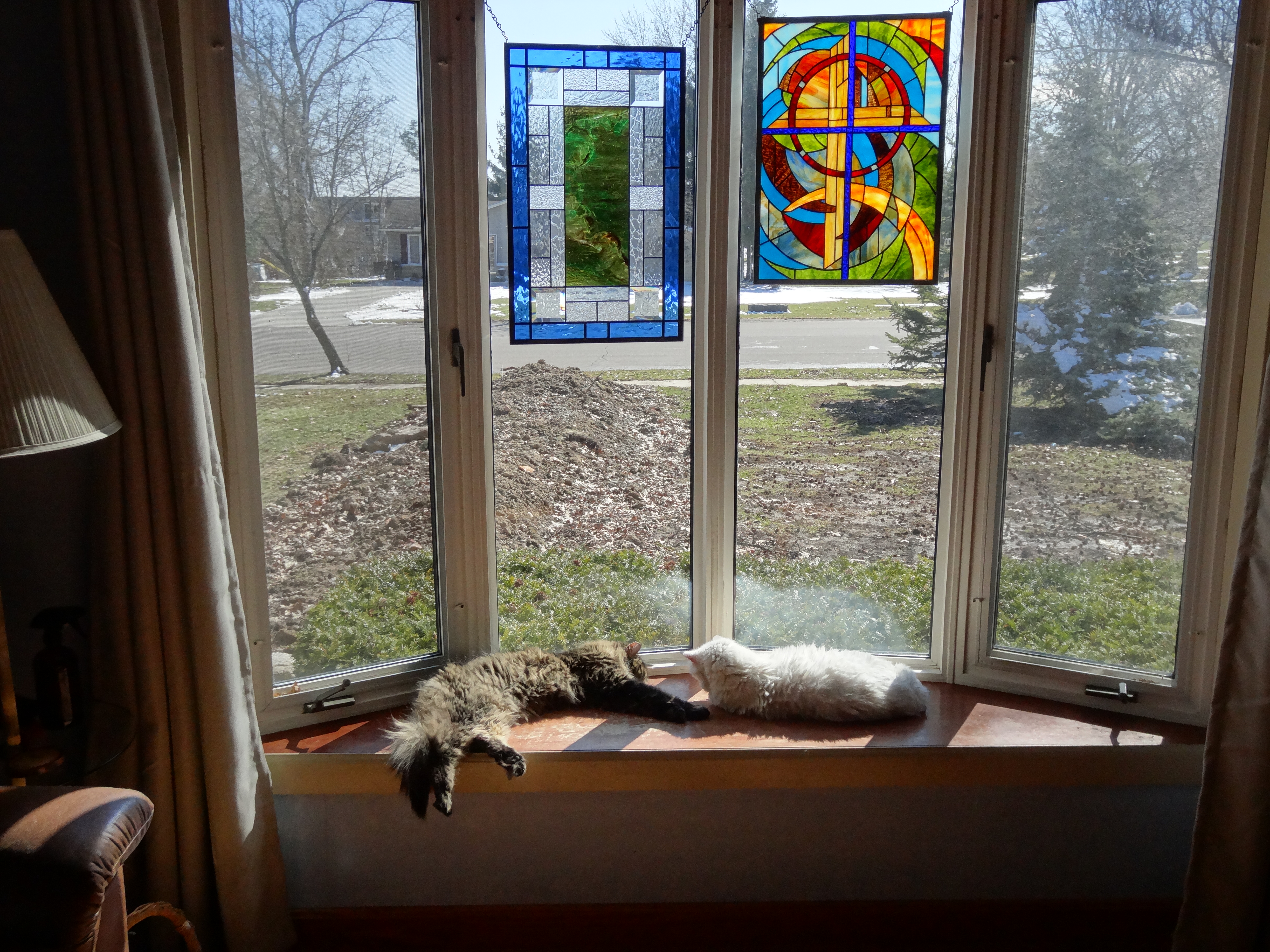 Over the years, the kitten experienced myriad changes, starting with a change of gender. When cats are tiny, their gender isn’t always obvious to the layperson. Initially, I’d thought the kitten was female, but others convinced us it was male, until a visit to the vet confirmed that she was female after all.
Over the years, the kitten experienced myriad changes, starting with a change of gender. When cats are tiny, their gender isn’t always obvious to the layperson. Initially, I’d thought the kitten was female, but others convinced us it was male, until a visit to the vet confirmed that she was female after all.
These shifting gender assumptions led to a change of names. When we’d believed the kitten was male, my aunt suggested Moses as an appropriate name, since the kitten was (sort of) found in the bulrushes, with parentage unknown. Upon confirmation that she was female, I went back to my original name pick: Enigma, because her origins were a mystery — but I figured we’d call her Emma for short. And we did, for a time; however, her name continued its metamorphosis. In our New Baltimore house, we had lacy curtains at various windows, and when Emma would jump up onto the windowsill, there was something vaguely bridal in the effect of a white cat behind white lace, so we started calling her “Miss Emma-sham,” in reference to the wedding- dress-wearing Miss Havisham in Dickens’s Great Expectations. This morphed into “Miss Shemma-shem” and then, ultimately, into “Shem-shem,” “Shemmy,” or “Shems.” These were the names that stuck, although “Shemony” was an occasional musical variation (“Shemony is ivory,” to the tune of “Ebony and Ivory,” and “Shem-shemony, Shem-shemony, Shem-shem sheroo,” to the tune of “Chim Chim Cher-ee”).
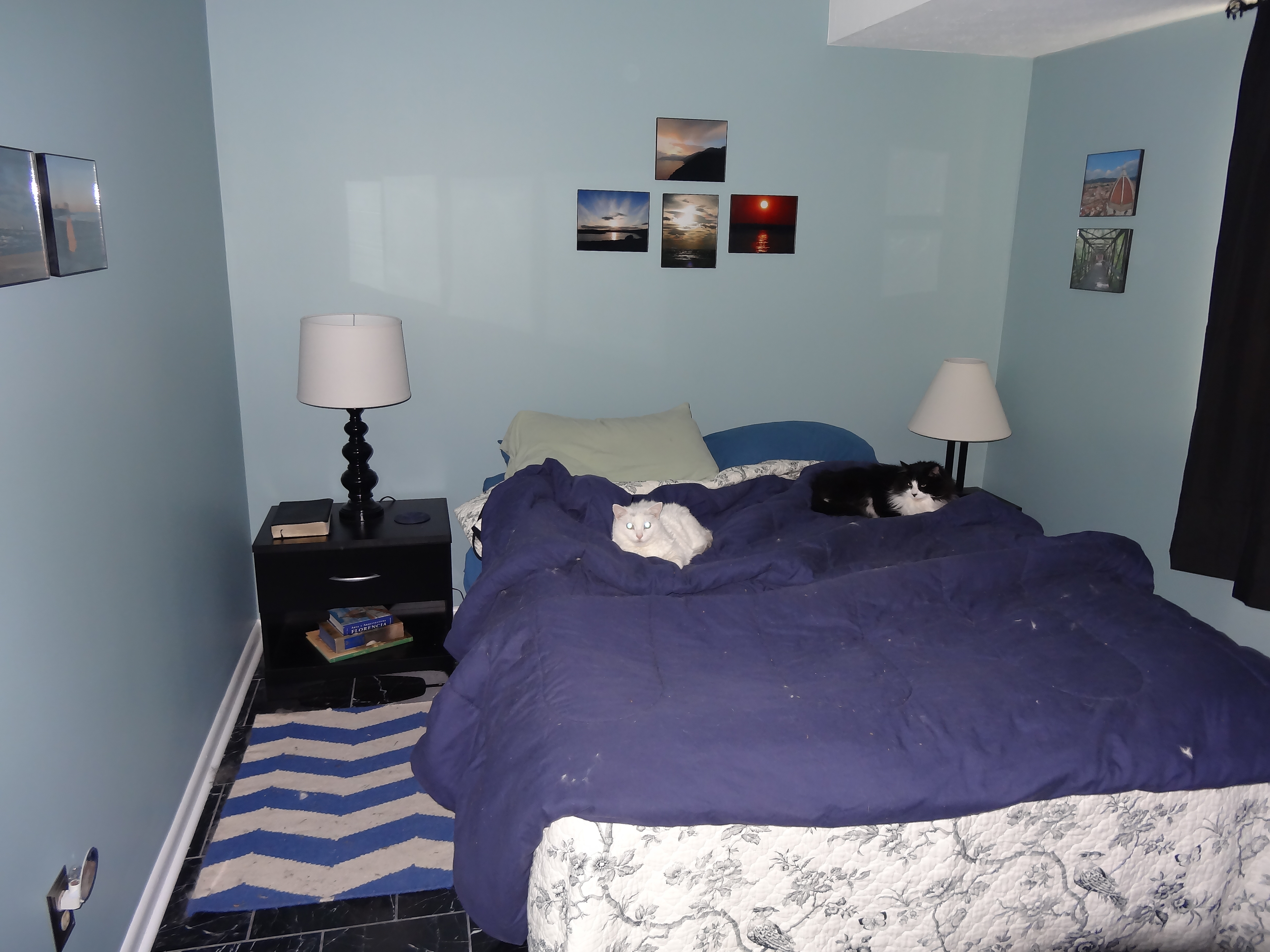
Along with a change of names, Shemmy underwent a change of looks as she got older. Cats are often at their cutest when they’re kittens, but that wasn’t the case with Shemmy. At first, because she was so little, and she kept looking rather wet about the face and paws, we called her the drowned-rat cat. She was mostly white, but had a dark gray splotch on her head that looked like an ill-fitting toupee. With age, though, she put on enough weight that she no longer looked scrawny, and her toupee lightened considerably, and she became obsessive about grooming, often feeling the need to do so immediately after we’d pet her (“washing off the mama-filth/ daddy-filth,” we’d say). Nonetheless, for a short-haired cat, she had oddly thick, coarse fur that sometimes defied her grooming attempts, especially when the weather turned colder. One fall, she even had a spiky ridge of fur clumps running from head to tail, as if she were some kind of feline-stegosaurus hybrid.
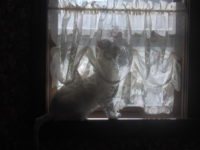 As Shemmy grew up, not only her looks but also her personality (or should I say “kitty-ality”?) changed for the better. Whether from nature or lack of feline nurture, she was a feral little thing. When she was tiny, Matthew would lie on the floor and let her climb onto his chest, which took some effort on her part. Then he would let her wrestle with his hand. Both of these playtime activities were cute, but the latter proved unwise, since the hand-wrestling game turned a bit more painful for Matthew as she got bigger, and her teeth and claws got sharper. Petting her semi-safely involved distracting her attention with one hand while petting her with the other (“Pet the snaky girl,” we’d say, remembering hearing that snakes can be most safely grabbed right behind the head). Recalling the commercial of our youth in which an owl is asked how many licks it takes to get to the center of a Tootsie Roll Tootsie Pop, we’d ask how many pets it took to get to the center of the Shemmy-fierce (i.e., before she’d try to attack us). As in the commercial, the answer generally seemed to be three. Shemmy’s fierceness extended to other cats as well as to us, particularly if they were female. After two failed attempts to take in other female cats, we promised each other, and Shems, that we wouldn’t try again as long as she was still with us. Shemmy even had an aggressive-sounding purr. The purring of most cats is a soothing, peaceful sound, but her purring was loud and fast, less “tender lullaby” and more “gentlemen, start your engines.”
As Shemmy grew up, not only her looks but also her personality (or should I say “kitty-ality”?) changed for the better. Whether from nature or lack of feline nurture, she was a feral little thing. When she was tiny, Matthew would lie on the floor and let her climb onto his chest, which took some effort on her part. Then he would let her wrestle with his hand. Both of these playtime activities were cute, but the latter proved unwise, since the hand-wrestling game turned a bit more painful for Matthew as she got bigger, and her teeth and claws got sharper. Petting her semi-safely involved distracting her attention with one hand while petting her with the other (“Pet the snaky girl,” we’d say, remembering hearing that snakes can be most safely grabbed right behind the head). Recalling the commercial of our youth in which an owl is asked how many licks it takes to get to the center of a Tootsie Roll Tootsie Pop, we’d ask how many pets it took to get to the center of the Shemmy-fierce (i.e., before she’d try to attack us). As in the commercial, the answer generally seemed to be three. Shemmy’s fierceness extended to other cats as well as to us, particularly if they were female. After two failed attempts to take in other female cats, we promised each other, and Shems, that we wouldn’t try again as long as she was still with us. Shemmy even had an aggressive-sounding purr. The purring of most cats is a soothing, peaceful sound, but her purring was loud and fast, less “tender lullaby” and more “gentlemen, start your engines.”
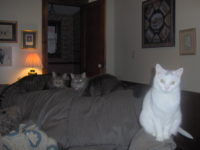 With age, Shemmy got noticeably mellower. After about a decade, she was a lot less likely to attack us when we’d pet her, and after a few more years, she was practically sweet. She never was much of a lap cat, but whenever we were on the couch, she’d almost always come sit between us. She had a talent for staring at us without moving and without blinking. A colleague who regularly drove by our house once asked us if the white cat in the window was real. Despite her seeming more standoffish than snuggly, she loved to have her nose rubbed, and if we leaned our faces down to hers, she’d touch noses in a “kitty kiss.” She also had trouble resisting the lure of the finger: if she was out of reach on the couch, one of us could just hold out our index finger, and she seemed to feel compelled to come close enough to sniff it.
With age, Shemmy got noticeably mellower. After about a decade, she was a lot less likely to attack us when we’d pet her, and after a few more years, she was practically sweet. She never was much of a lap cat, but whenever we were on the couch, she’d almost always come sit between us. She had a talent for staring at us without moving and without blinking. A colleague who regularly drove by our house once asked us if the white cat in the window was real. Despite her seeming more standoffish than snuggly, she loved to have her nose rubbed, and if we leaned our faces down to hers, she’d touch noses in a “kitty kiss.” She also had trouble resisting the lure of the finger: if she was out of reach on the couch, one of us could just hold out our index finger, and she seemed to feel compelled to come close enough to sniff it.
Our house, too, changed because of having Shemmy in it. For one thing, it got furrier: she shed more than any cat we’ve ever known, and we’re not the most diligent housekeepers. But to make sure that we didn’t go too long without washing our floors — or without washing patches of them, at least — Shemmy would throw up from time to time, with those times being particularly frequent during her kittenhood and in her golden years. In itself, this isn’t so unusual: lots of cats have somewhat temperamental digestive systems. However, what set Shemmy’s barfing apart was the artistry she put into it. While throwing up, she’d turn in a wide arc, creating room-spanning splatter patterns. Kind of a Pollock of puke, she was.
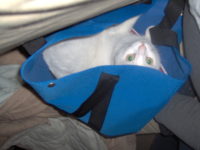 The throwing up never left a permanent mark, but Shemmy did do permanent damage to one of our beds in her younger years. Sometimes, cats are masterful at disappearing for hours at a time, unfindable to their seeking owners until the cats decide (often around dinnertime) that they’re ready to materialize. One day, though, when looking for Shems under the bed in the guest room, I noticed a bulge in the fabric lining the bottom of the box-spring part of the mattress. Reaching under the bed to touch the bulge, I found it solid, warm … and purring. Shemmy had slowly and steadily been pulling out some of the stuffing to make herself a little nest.
The throwing up never left a permanent mark, but Shemmy did do permanent damage to one of our beds in her younger years. Sometimes, cats are masterful at disappearing for hours at a time, unfindable to their seeking owners until the cats decide (often around dinnertime) that they’re ready to materialize. One day, though, when looking for Shems under the bed in the guest room, I noticed a bulge in the fabric lining the bottom of the box-spring part of the mattress. Reaching under the bed to touch the bulge, I found it solid, warm … and purring. Shemmy had slowly and steadily been pulling out some of the stuffing to make herself a little nest.
I can’t say I always shared Shemmy’s taste in home decor. For years, most of our cats have used the litter boxes in the basement, but if we didn’t keep a litter box in the kitchen for Shemmy, she’d poop on the floor. And when she got arthritic as a senior cat, we wanted to make sure she could still get up on the couch to join us, so we put out a step stool to help her. The one we had on hand was a cheap white plastic one stained with green paint, and it was only intended to be a temporary measure — yet when I ordered a cute wooden step stool, it was apparently not sufficiently stable, and Shems wouldn’t use it. I tried again with a sturdier wooden one, but nothing doing: the ugly plastic one became part of our living room furniture, and I just tried to remember to hide it in a bedroom whenever we had company.
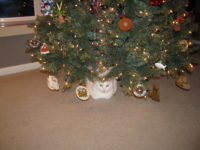 In addition to the changes in our house, and in Shemmy, since she first came into our lives, our lives themselves changed. She became part of our home in August of 2001, within weeks of our moving back to Ohio. Matthew had just started working as the IT guy at CVCA, and I’d just started teaching eighth grade English at Jackson Middle School. Since that time, some of the changes have been positive ones. For example, I got my master’s degree and a job at CVCA, and we bought a house within walking distance of the school. But we’ve also experienced a lot of loss in recent years. It’s startling to think that when Shemmy was a kitten, my parents were still alive, as was Matthew’s father, as were Grammy and Grampy Wooster, Grandpa Johnson, Uncle Frank and Aunt Jean, Uncle Bob and Aunt Zovie … in Shemmy’s kittenhood, I don’t think any of them were even sick, let alone gone.
In addition to the changes in our house, and in Shemmy, since she first came into our lives, our lives themselves changed. She became part of our home in August of 2001, within weeks of our moving back to Ohio. Matthew had just started working as the IT guy at CVCA, and I’d just started teaching eighth grade English at Jackson Middle School. Since that time, some of the changes have been positive ones. For example, I got my master’s degree and a job at CVCA, and we bought a house within walking distance of the school. But we’ve also experienced a lot of loss in recent years. It’s startling to think that when Shemmy was a kitten, my parents were still alive, as was Matthew’s father, as were Grammy and Grampy Wooster, Grandpa Johnson, Uncle Frank and Aunt Jean, Uncle Bob and Aunt Zovie … in Shemmy’s kittenhood, I don’t think any of them were even sick, let alone gone.
And now we’ve lost another member of our family. To be honest, we were pleasantly surprised that Shemmy survived 2020 — most cats don’t make it to nineteen years old. However, though she was obviously slowing down, and though she was troubled with frequent ear problems, she didn’t have any life-threatening physical ailments, to our knowledge. So when spring break rolled around and we finally had the chance to travel, at least domestically, we took it. Unfortunately, it turned out that in saying goodbye to Shemmy before our trip, we were saying goodbye for the last time. When we got home on the Saturday of Easter weekend, Matthew went inside first. I was still in the garage when he came back out and told me that Shemmy had died. To our great relief, she had still been alive — and in the kitchen for food — when our friend Liz had come to take care of the cats the day before. We’re also grateful that our friend Dubbs, who’d been our cat-sitter earlier in the week, had spent some quality time with her in her final days.
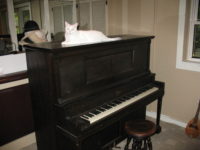 So the Grim Reaper finally came back for our little Shems. I knew that even she couldn’t hold him off indefinitely … but I’m glad she succeeded for almost twenty years.
So the Grim Reaper finally came back for our little Shems. I knew that even she couldn’t hold him off indefinitely … but I’m glad she succeeded for almost twenty years.
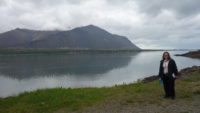 For the first time since November of 2019, we’re back on foreign soil! A deep gratitude to God and many thanks to the medical researchers, policy makers, and common people’s best efforts to get us to this point. Thank you, all!
For the first time since November of 2019, we’re back on foreign soil! A deep gratitude to God and many thanks to the medical researchers, policy makers, and common people’s best efforts to get us to this point. Thank you, all!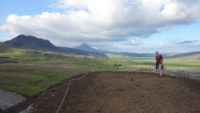 We drove about an hour and forty-five minutes north to the small town of Borgarnes. We certainly got a taste of traveling in Iceland – we drove from mist to rain to mist to rain to cloudy (which was a happy progression for landing in a town we wanted to tour). We also traversed lava fields, green pastures, the outskirts of Reykjavik, drove under a fjord in a three-mile tunnel, and were dwarfed by roadside mountains. This is going to be fun (not to mention beautiful).
We drove about an hour and forty-five minutes north to the small town of Borgarnes. We certainly got a taste of traveling in Iceland – we drove from mist to rain to mist to rain to cloudy (which was a happy progression for landing in a town we wanted to tour). We also traversed lava fields, green pastures, the outskirts of Reykjavik, drove under a fjord in a three-mile tunnel, and were dwarfed by roadside mountains. This is going to be fun (not to mention beautiful).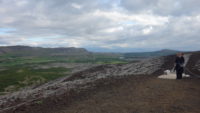 After showering and eating at a local restaurant (where I saw horse on the menu for the first time; I got beef), we jumped in the car and headed off through incredible countryside for about thirty minutes, until we got to Grabrok Crater, a very small extinct volcano. The area is still very rugged since the volcano erupted only about three thousand years ago, but the locals installed a boardwalk with steps all the way to the top. The views of the surrounding countryside kept changing as we climbed, and the views from the top were photogenic. Meredith is very patient with my “Wait! Stop!” moments of reaching for the camera. There is a path all around the lip of the crater, and we took our time strolling along it. The evening was pleasant, and the weather was very good.
After showering and eating at a local restaurant (where I saw horse on the menu for the first time; I got beef), we jumped in the car and headed off through incredible countryside for about thirty minutes, until we got to Grabrok Crater, a very small extinct volcano. The area is still very rugged since the volcano erupted only about three thousand years ago, but the locals installed a boardwalk with steps all the way to the top. The views of the surrounding countryside kept changing as we climbed, and the views from the top were photogenic. Meredith is very patient with my “Wait! Stop!” moments of reaching for the camera. There is a path all around the lip of the crater, and we took our time strolling along it. The evening was pleasant, and the weather was very good.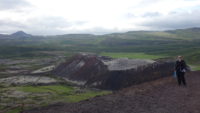 Grabrok Crater was the only touristic goal of the day. We took the car back to Borgarnes and settled in for a fairly early evening. We indeed have many things to be thankful for.
Grabrok Crater was the only touristic goal of the day. We took the car back to Borgarnes and settled in for a fairly early evening. We indeed have many things to be thankful for.